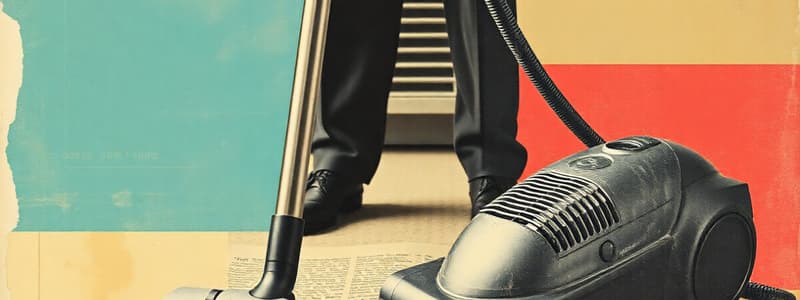Podcast
Questions and Answers
What is the recommended action to take when starting to vacuum a room?
What is the recommended action to take when starting to vacuum a room?
- Use the vacuum cleaner to pick up small items
- Vacuum around furniture without moving it
- Begin at the entrance of the room
- Start vacuuming from the furthest point from the exit (correct)
Which attachment should be used to clean furniture and upholstery effectively?
Which attachment should be used to clean furniture and upholstery effectively?
- Power nozzle
- Floor brush
- Crevice tool
- Small brush (correct)
What should be done with rags and sponges after use?
What should be done with rags and sponges after use?
- Store them in the cleaning bucket
- Leave them damp for reuse
- Soak them in disinfectant
- Wash and allow to dry (correct)
Which of the following is NOT a recommended practice for using a toilet bowl brush?
Which of the following is NOT a recommended practice for using a toilet bowl brush?
What is the appropriate step to take when using spray nozzle bottles?
What is the appropriate step to take when using spray nozzle bottles?
Which tool is specifically designed for cleaning toilet bowls?
Which tool is specifically designed for cleaning toilet bowls?
What is the primary function of a Feather Duster?
What is the primary function of a Feather Duster?
Which cleaning tool can be used to protect the user’s eyes from harmful chemicals?
Which cleaning tool can be used to protect the user’s eyes from harmful chemicals?
What purpose does the Warning Sign serve during cleaning operations?
What purpose does the Warning Sign serve during cleaning operations?
Which cleaning tool is primarily used for mopping purposes?
Which cleaning tool is primarily used for mopping purposes?
Which item is best suited for removing excess water from surfaces after cleaning?
Which item is best suited for removing excess water from surfaces after cleaning?
What is the main use of a Scouring Pad?
What is the main use of a Scouring Pad?
What is the purpose of the Maid's Cart?
What is the purpose of the Maid's Cart?
What is the primary function of a dust pan?
What is the primary function of a dust pan?
What type of vacuum cleaner is specifically designed for both wet and dry surfaces?
What type of vacuum cleaner is specifically designed for both wet and dry surfaces?
Which cleaning equipment is a non-electric option used to clean carpeted floors?
Which cleaning equipment is a non-electric option used to clean carpeted floors?
Which cleaning chemical is primarily used to emulsify grease?
Which cleaning chemical is primarily used to emulsify grease?
What is a key tip for using cleaning products effectively?
What is a key tip for using cleaning products effectively?
What is the purpose of the ladder in cleaning tasks?
What is the purpose of the ladder in cleaning tasks?
Which cleaning equipment is specifically designed for stripping floors?
Which cleaning equipment is specifically designed for stripping floors?
What should be checked regularly on a vacuum cleaner for maintenance?
What should be checked regularly on a vacuum cleaner for maintenance?
Flashcards are hidden until you start studying
Study Notes
Vacuuming Techniques
- Start vacuuming from the furthest point, moving toward the exit to avoid backing into dirt.
- Use hands to pick up small objects before vacuuming to prevent clogs.
- Different attachments for specific surfaces:
- Crevice tool for corners and ledges.
- Small brush for upholstery and drapes.
- Floor brush for hard surfaces.
- Power nozzle for carpets.
- Regular maintenance includes cleaning the vacuum and reporting any issues.
Ladder Safety
- Ensure ladder is on a stable, flat surface and locked into position.
- Position ladder close to the object rather than overreaching for safety.
Cleaning Tools and Their Uses
- Toilet Bowl Brush: Used exclusively for cleaning the inside of toilet bowls and should be stored in a caddy.
- Push Mop: Dry dust mop that requires a clean mop head before use.
- Floor Mop: Wet mop that must be cleaned after each use, rinsed with disinfectant, squeezed out, and hung to dry.
- Dusters: Use a consistent direction when dusting, clean after use.
- Buckets: Must be labeled for specific tasks, filled to no more than ¾ capacity, and cleaned after use.
- Rags and Sponges:
- Use damp cloths for dusting, separate ones for bathrooms.
- Clean after use and never mix sponges used for toilets with other surfaces.
Gloves and Safety Equipment
- Use appropriate gloves:
- Disposable for bed stripping.
- Heavy-duty for toilet cleaning.
- Industrial-strength for hazardous materials.
- Clean reusable gloves after each use.
- Use spray nozzle bottles only with authorized products and check for leaks.
Maid's Cart/Trolley
- Facilitates the transportation of linens, equipment, and supplies for efficient service.
Specific Cleaning Tools
- Hand Brush: For dusting.
- Scouring Pad: For scrubbing.
- Cobweb Brush: Reaches difficult areas like ceilings.
- Feather Duster: Ideal for delicate dusting tasks.
Cleaning Equipments
- Upright Vacuum Cleaner: Effective for both hard and carpeted floors.
- Wet & Dry Vacuum: Suitable for various surface conditions.
- Carpet Sweeper: A non-electric option for quick cleaning.
- Extractor: Cleans carpets deeply by extracting trapped dirt.
Cleaning Chemicals
- Categories include detergents, bleach, disinfectants, deodorizers, and more specialized products for specific functions (e.g., drain cleaners for clogs).
- Use cleaning products as per manufacturer instructions to ensure safety and effectiveness.
Tips for Cleaning Product Usage
- Always check tools and work equipment for functionality before use.
- Adhere to cleaning product instructions to prevent waste and misuse.
- Regularly check and maintain vacuum cleaner components for optimal performance.
Studying That Suits You
Use AI to generate personalized quizzes and flashcards to suit your learning preferences.




